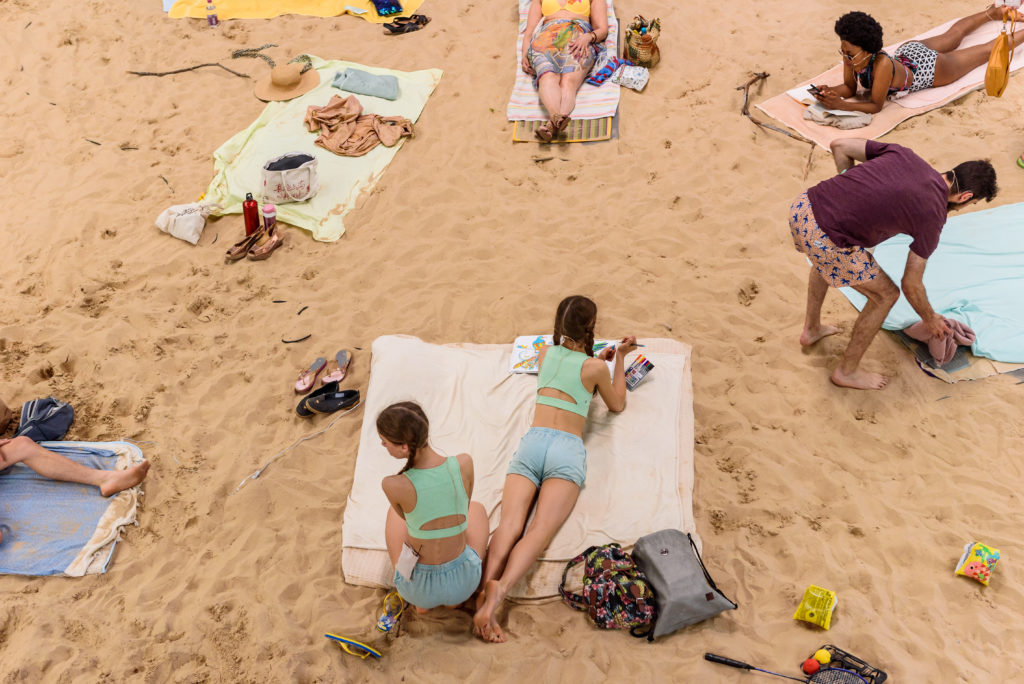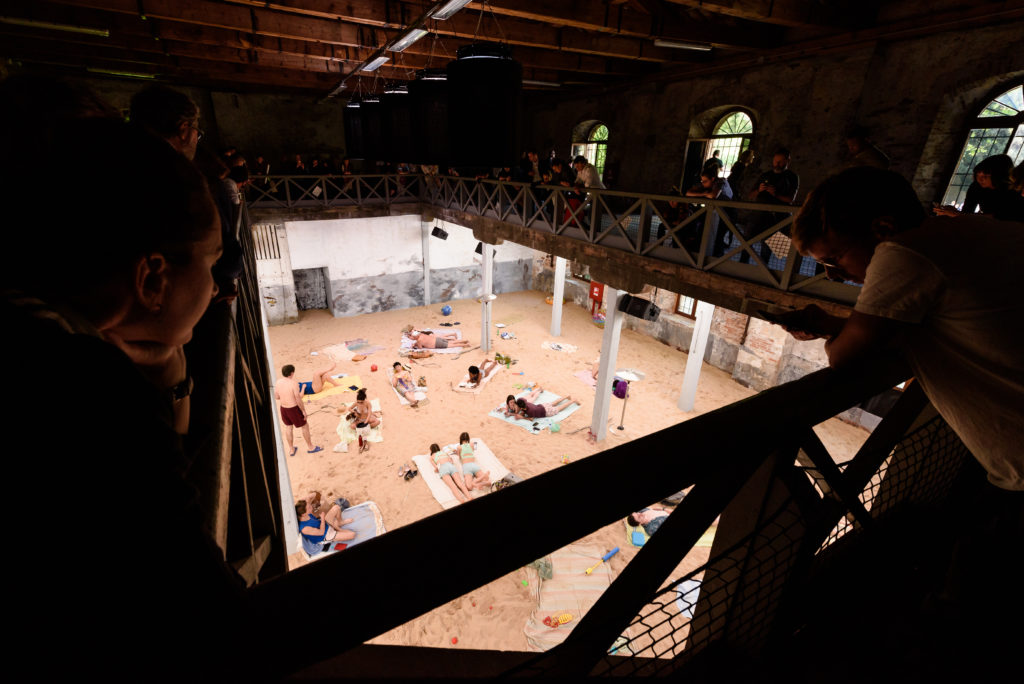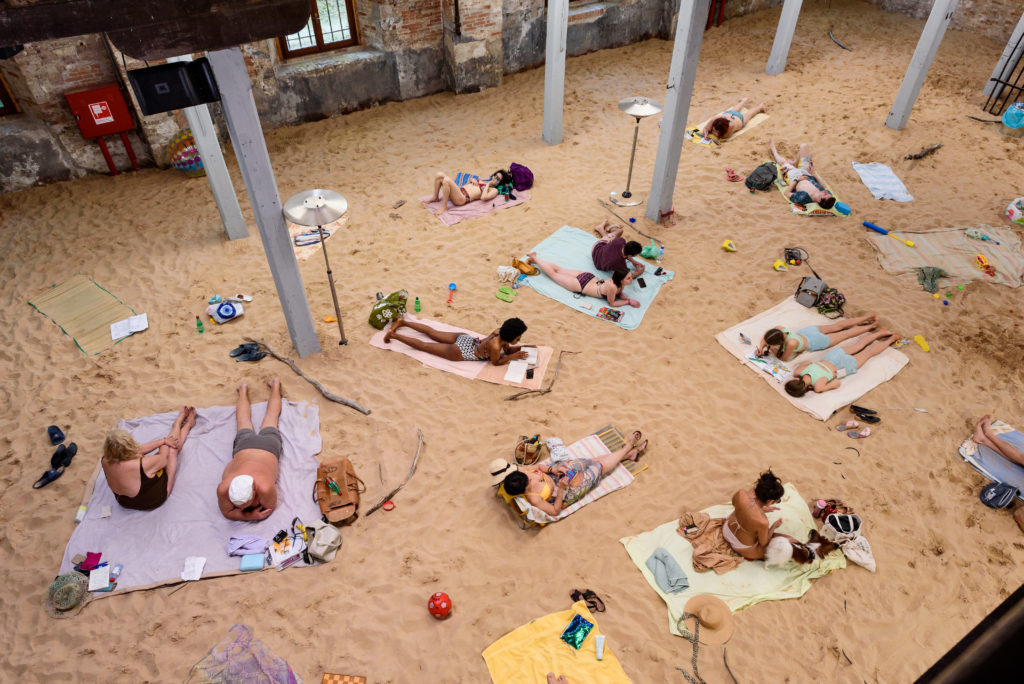Gathered on This Beach: Sun & Sea, Lithuanian Pavilion
by Natalie Hegert

In this last of meeting places
We grope together
And avoid speech
Gathered on this beach of the tumid river…
This is the way the world ends
This is the way the world ends
This is the way the world ends
Not with a bang but a whimper.— T.S. Eliot, The Hollow Man
Ah well, what matter, that’s what I always say,
it will have been a happy day, after all, another
happy day.
— Samuel Beckett, Happy Days
In Nevil Shute’s 1957 novel, On the Beach, his characters—among the last people alive in the world after a hemispheric atomic war—live out their final days waiting for an inevitable cloud of radiation borne by global air currents to finally make its way to the southern tip of Australia. The book is boring and hopeless, as are these last humans puttering in their gardens to plant flowers that no one will ever see, taking on last minute efforts at self-improvement, worrying about sex and fidelity.
“Couldn’t anyone have stopped it?” the wife asks helplessly in their final hour.
“I don’t know…” her husband replies patronizingly. “Some kinds of silliness you just can’t stop,” he says, referring to the nuclear war that annihilated the planet.
The much-acclaimed opera-installation Sun & Sea (Marina), in the Lithuanian Pavilion at the 58th Venice Biennale, likewise portrays passive, helpless bystanders to the end of the world, but it is a much more ambiguous apocalypse. A group of disconnected vacationers lounge on the sand of a nameless beach—at first nothing seems amiss, but as they sing, the details of their world come into focus. “The colors of the sea and sky have changed,” they sing. The sea is “as green as a forest”—owing to the process of eutrophication1—the Great Barrier Reef is a “bleached, pallid whiteness.” They complain of sunburns and strange weather, airport delays and trash on the beach. Their concerns are immediate and minor, while the world is clearly falling apart around them.
While other depictions of a post-climate-disaster world succumb to visions of the apocalyptic sublime—such as Waterworld (1995), or Mad Max (1979)—Sun & Sea is decidedly restrained, non-epic, banal. Instead of a deliciously outlandish doomsday scenario, it is just a rather disappointing day at the beach. In both setting and attitude, the installation more closely recalls the absurdist play Happy Days by Beckett,2 which finds its protagonist buried in a mound of sand, furtively trying to maintain a semblance of normalcy in her life. Likewise, the characters of Sun & Sea, though they find it strange, have clearly adapted to the new normal. And while it is clear that “Everything is out of joint” in the climate, it seems there is nothing to be done (“There is so little one can do,” laments the protagonist of Happy Days). So, you might as well try to enjoy yourself: “After vacation, / Your hair shines, / Your eyes glitter, / Everything is fine,” they sing.
Staff Writer Natalie Hegert speaks with theater director Rugilė Barzdžiukaitė, playwright Vaiva Grainytė, and composer Lina Lapelytė about their Golden Lion-winning production and the message behind it.
Natalie Hegert: Not only has Sun & Sea received abundant and unanimous praise among the critics and the most prestigious prize at the Biennale, it is also proving to make a most lasting impression on spectators and continues to be talked about. Did you have any idea your contribution to the Biennale would be received like this?
Rugilė Barzdžiukaitė: This was beyond our expectations of course. Vaiva Grainyte˙: If you ask me, I felt our opera-performance might look distinguishing in the context of Biennale, but we did not have much time to think about success—the logistics and preparation were quite challenging and intense.
Lina Lapelytė: It was not an easy project and it was risky on many levels—so the jury team in Lithuania already was brave enough to select it. What happened during the first week of biennale feels like something that almost does not belong to us. Someone said, It is a Cinderella story.

This was definitely not written in our scenario. Before the opening, we were preparing our performers to be ready for an almost empty pavilion and find a joy in performing if there was only one member of the audience. Now during the performance days, we receive an average of 1,300 people. Every role on the beach has to have at least three people able to perform it.
NH: Why did you create this as an opera, as opposed to another kind of performance art, theatrical spectacle, or visual art? How did you approach its staging within the context of the Biennale—to place it among what is primarily a showcase of visual arts? Was it much different from its first staging, in Lithuania (besides the language)?
Vaiva Grainytė: Our trio started with debut piece Have a Good Day! (2014)—a contemporary opera for ten singing cashiers, supermarket sounds, and piano. I find opera to be the perfect genre for us to unite our artistic practices (text, music, and visuality). Nonetheless, the durational version of Sun & Sea crosses the boundaries of other arts. ‘Opera,’ I would say, indicates the marriage of different arts, but this piece itself can be called something else: installation, architectural poetry, concert…
LL: Opera is a very particular place for the three of us—we kind of invented a method of working in this genre. Opera is as visual art as any other kind of installation, sculpture, or painting. The genre itself often belongs to the music world but personally, in my own practice, prefer to look at music—opposed to the idea that it is only for listening. Opera is literature; it is music; it is fine arts. It is a gesamtkunstwerk, and none of the features are more important than the other.
RB: Sun & Sea grew from the visual, and still is a very visual work. Other elements—mainly text and music—bring different layers, form-wise, so the work becomes more complex. However, in this complexity we seek for simplicity.
NH: One of the things that is so striking is the opera’s placidness. There seem to be no great highs or lows, no climax or crescendo, no great emotion expressed. The singers are, for the most part, singing while lying down. There is very little movement, most of it being incidental, and the musical accompaniment is minimal. Even the scenery is quite pared down—there is simply sand, with no unusual lighting or representation of the kind of toxic sea that is suggested by the libretto. It is anti-apocalyptic, but also almost anti-theatrical. Can you tell me why you decided to present it in this way?
RB: You have put it in very right words. We have static bodies, but very often their minds are active, transforming from reminiscences to reflections, dreams, etc. Waves of these inner monologues grow into choirs, then flood back into solos again. Performers are static while they are singing, but other times they are free to move alongside kids, dogs, and other volunteers who are building castles, playing beach games, eating, etc. This brings uncontrolled reality into the fictional construct.
LL: In our case, the representation is based on a very clear conceptual grounding—all the further details of the work follow that concept. We try to restrain ourselves from using self-oriented tricks and effects; therefore, most of the details are there because of the true necessity.
VG: The light picture of lazy holidays is just a surface: we are sunbathing while the world is crashing.
NH: What kind of research into climate change and its effects did you undertake to imagine the world of Sun & Sea?
LL: The research spanned from mainstream media, scientific investigations, personal views, experiences and dreams, and conversations and reflections.
VG: Before writing the libretto, the research was done. It was necessary to understand what CO2, emissions and food miles are, and why our planet is in its current state. After dealing with that scientific information, we came up with the realization that catastrophe is caused by our—homo sapiens—uncontrollable consumption. Consumption, which is so pleasant and stands as the core of our lives. The idea was to reveal the tragedy by personal approach, employing micro-stories, as ecology is such a huge topic. That is to say, disastrous pictures of dying and choked-in-plastic animals seem to be too anonymous, too difficult for our brains to process what is happening.
RB: Climate change is such a popular topic, but we did not want to manifest scientific facts, or to be moralistic. It was important to deepen the knowledge in this field. We were reading specific literature, but Sun & Sea is not about facts at all. It is about mundane narratives of holidaymakers, surrounded by apocalypse. But on a daily basis [it reflects something] other than that.
NH: What kind of message did you set out to impart? Do you feel that the installation gives any sense of hope for our future? Or is this scene something of a foregone conclusion for our world?
VG: It is up to each spectator to read the message on their own. The mosaic of characters and their songs suggest a kaleidoscopic approach, so there is no conclusion or “one truth” as such.
RB: To expand the beach topic in a global perspective: sunbathing may soon become available where polar bears used to live. I think we are neither giving a sense of hope for the future, nor taking it away. We do not know the right answer, and this is probably our luck.

LL: The work is a question, but also a reflection, on where we are and who we are, but the hope is in every one of us. In the tiny things, the love that we all share. Though that love must also be super critical and questioning many things that are taken for granted. It is hard!
NH: You three have worked together before, on the opera Have a Good Day!, and Sun & Sea is your second collaboration. In light of your spectacular success, do you have plans to work together again?
VG: Success might breed rush and greediness, but our trio is rather slow in terms of developing a new piece. Each piece needs time and mental energy so it could grow in a healthy way. After this prolonged Venetian adventure (the performance is running twice a week until the end of October) we need some time to reflect on what has happened, plus a tour with Sun & Sea will require special attention. We have some ideas for a new work, so probably one day it will be embodied.
RB: Each of us have individual practices, which are extremely important for our common work; everything we learn separately we bring in as an experience. I think we all need some separate creative space and time before considering going into the next trio work.
LL: We do not force the situation and it may take some time for us to come up with a new idea for a collaborative work. The fact that we all have individual practices makes things slower, but also creates a real need for coming back together.
The Pavilion of Lithuania, Sun & Sea (Marina), at the Venice Biennale ran through October 31, 2019.